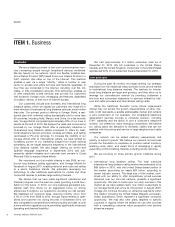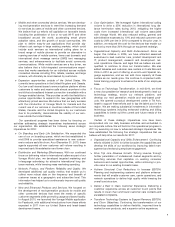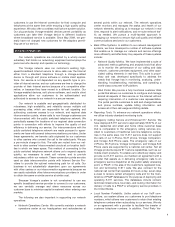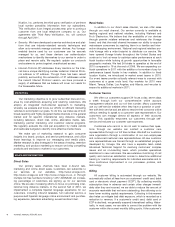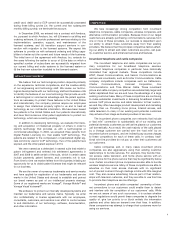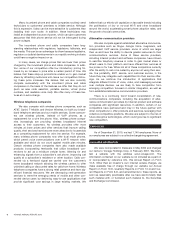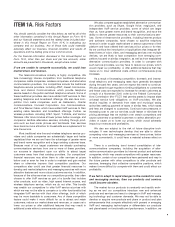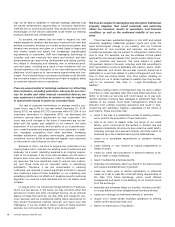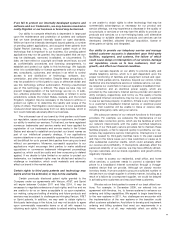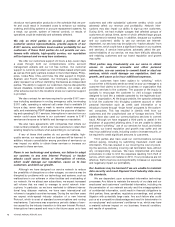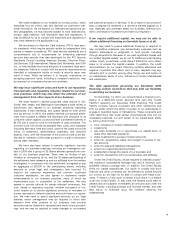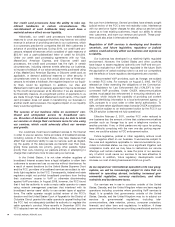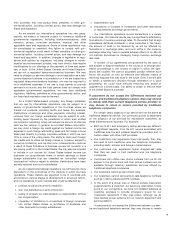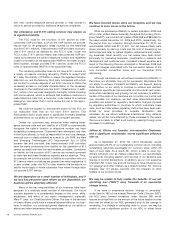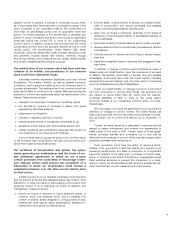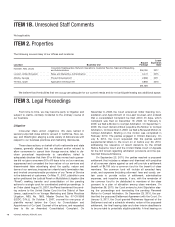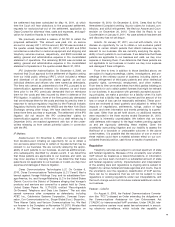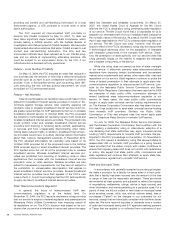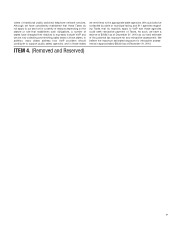Vonage 2010 Annual Report Download - page 18
Download and view the complete annual report
Please find page 18 of the 2010 Vonage annual report below. You can navigate through the pages in the report by either clicking on the pages listed below, or by using the keyword search tool below to find specific information within the annual report.I
f
we
f
ail to protect our internally developed systems an
d
software and our trademarks, we ma
y
become involved in
cost
l
y
li
t
i
gat
i
on or our
b
us
i
ness or
b
ran
d
may
b
e
h
arme
d
.
O
ur ability to compete effectively is dependent in large part
upon the maintenance and protection of s
y
stems and software
th
at we
h
ave
d
eve
l
ope
di
nterna
lly b
ase
d
on open stan
d
ar
d
s
.
While we have five internall
y
developed issued patents, a numbe
r
of pending patent applications, and acquired three patents fro
m
Digital Packet Licensing, Inc., we cannot patent much of th
e
t
echnology that is important to our business.
O
ur pending patent
app
li
cat
i
ons may not
b
e grante
d
.
A
ny
i
ssue
d
patent t
h
at we ow
n
may
b
ec
h
a
ll
enge
d
, narrowe
d
,
i
nva
lid
ate
d
,orc
i
rcumvente
d
.
T
o
d
ate, we
h
ave re
li
e
d
on copyr
i
g
h
tan
d
tra
d
e secret
l
aws, as we
ll
as confidentiality procedures and licensing arrangements, t
o
esta
bli
s
h
an
d
protect our r
i
g
h
ts to t
hi
s tec
h
no
l
ogy.
W
e typ
i
ca
ll
y
enter into confidentiality or license agreements with our employ
-
ees
,
consultants
,
customers
,
and vendors in an effort to contro
l
access to and distribution of technology, software, doc-
umentation, and other information. Despite these precautions, it
ma
y
be possible for a third part
y
to cop
y
or otherwise obtain an
d
use this technolo
g
y without authorization. Policin
g
unauthorized
use of this technolo
g
y is difficult. The steps we take may no
t
p
revent misappropriation of the technolo
g
y we rely on. In addi-
t
ion, effective protection may be unavailable or limited in some
j
urisdictions outside the United
S
tates,
C
anada, and the United
Kin
g
dom. Liti
g
ation may be necessary in the future to enforce o
r
p
rotect our ri
g
hts or to determine the validity and scope o
f
th
e
r
i
g
hts o
f
others. That liti
g
ation could cause us to incur substantia
l
costs and divert resources away
f
rom our daily business, which i
n
t
urn could materially adversely a
ff
ect our business
.
T
he unlicensed use of our brand b
y
third parties could harm
our reputation, cause confusion among our customers, and impair
our a
bili
ty to mar
k
et our serv
i
ces.
T
ot
h
at en
d
,we
h
ave reg
i
stere
d
numerous trademarks and service marks and have a
pp
lied fo
r
r
e
g
istration of our trademarks and service marks in the United
S
tates and abroad to establish and
p
rotect our brand names as
p
art of our intellectual property strate
g
y. If our application
s
r
eceive objections or are successfully opposed by third parties, i
t
will be difficult for us to prevent third parties from usin
g
our bran
d
without our
p
ermission. Moreover, success
f
ul o
pp
osition to ou
r
applications mi
g
ht encoura
g
e third parties to make additiona
l
oppositions or commence trademark in
f
rin
g
ement proceedin
gs
a
g
ainst us, which could be costly and time consumin
g
to de
f
end
a
g
ainst. I
f
we decide to take limited or no action to protect our
t
rademarks, our trademark ri
g
hts may be diluted and subject t
o
challen
g
e or invalidation, which could materially and adversely
a
ff
ect our brand in the market
p
lace
.
Certain rights to third party patents and technology ma
y
exp
i
re an
d
not
b
e exten
d
e
d
, or may not
b
e ava
il
a
bl
e
.
C
ertain previously disclosed patent ri
g
hts
g
ranted to th
e
C
ompany under our a
g
reements with Verizon, AT&T, and Sprint
will expire between October 2011 and May 2014. It may b
e
necessary to ne
g
otiate extensions o
f
such ri
g
hts, and i
f
so and w
e
are unable to do so on terms acce
p
table to us u
p
on ex
p
iration,
our makin
g
, usin
g
and sellin
g
o
f
existin
g
and
f
uture products and
s
ervices may be subject to challen
g
es as in
f
rin
g
in
g
Verizon, AT&
T
or Sprint patents. In addition, we may seek to obtain ri
g
hts t
o
t
hird party technolo
g
y in the
f
uture, but may not be able to a
g
re
e
upon commerc
i
a
ll
y reasona
bl
e terms or at a
ll
w
i
t
h
respect t
o
obtainin
g
such ri
g
hts. I
f
we are unable to extend existin
g
licenses
or are unable to obtain ri
g
hts to other technolo
g
y that may b
e
commercially advanta
g
eous or necessary
f
or our product an
d
s
ervice o
ff
erin
g
s, we may experience a decrease in the quality o
f
our products or services or we may lose the ability to provide ou
r
p
roducts and services on a non-in
f
rin
g
in
g
basis until alternativ
e
t
echnolo
g
y or suitable alternative products and services can b
e
developed, identified, obtained (throu
g
h acquisition, license o
r
other
g
rants of ri
g
hts), and inte
g
rated
.
O
ur ability to provide our telephony service and manag
e
related customer accounts is de
p
endent u
p
on third-
p
art
y
f
acilities, equipment, and systems, the
f
ailure o
f
which
could cause delays or interruptions o
f
our service, dama
ge
our re
p
utation, cause us to lose customers, limit our
growth, and a
ff
ect our
f
inancial condition
.
O
ur success depends on our abilit
y
to provide qualit
y
and
r
e
li
a
bl
ete
l
ep
h
on
y
serv
i
ce, w
hi
c
hi
s
i
n part
d
epen
d
ent upon t
he
p
roper functioning of facilities and equipment owned and oper
-
ated b
y
third parties and is, therefore, be
y
ond our control. Unlike
t
ra
di
t
i
ona
l
w
i
re
li
ne te
l
ep
h
one serv
i
ce or w
i
re
l
ess serv
i
ce, our serv-
i
ce requ
i
res our customers to
h
ave an operat
i
ve
b
roa
db
an
dI
nter
-
net connect
i
on an
d
an e
l
ectr
i
ca
l
power supp
ly
,w
hi
c
h
are
p
rov
id
e
dby
t
h
e customer
’
s
I
nternet serv
i
ce prov
id
er an
d
e
l
ectr
ic
utilit
y
compan
y
, respectivel
y
, and not b
y
us. The qualit
y
of some
b
roadband Internet connections ma
y
be too poor for customers
t
o use our services properl
y
. In addition, if there is an
y
interruption
t
o a customer
’
s
b
roa
db
an
dI
nternet serv
i
ce or e
l
ectr
i
ca
l
powe
r
s
upp
ly
,t
h
at customer w
ill b
e una
bl
etoma
k
e or rece
i
ve ca
ll
s
,
i
nc
l
u
di
ng emergency ca
ll
s, us
i
ng our serv
i
ce
.
We outsource several o
f
our network
f
unctions to third-part
y
p
roviders. For example, we outsource the maintenance o
f
our
r
egional data connection points, which are the
f
acilities at which
our networ
ki
nterconnects w
i
t
h
t
h
epu
bli
csw
i
tc
h
e
d
te
l
ep
h
on
e
network. I
f
our third-part
y
service providers
f
ail to maintain these
facilities properl
y
, or fail to respond quickl
y
to problems, our cus
-
t
omers ma
y
exper
i
ence serv
i
ce
i
nterrupt
i
ons.
I
nterrupt
i
ons
i
nou
r
s
ervice caused b
y
third-part
y
facilities have in the past caused
and ma
y
in the future cause us to lose customers or cause us t
o
offer substantial customer credits, which could adversel
y
affec
t
our revenue and profitabilit
y
. If interruptions adversel
y
affect th
e
p
erceived reliabilit
y
of our service, we ma
y
have difficult
y
attract
-
i
ng new customers, an
d
our
b
ran
d
, reputat
i
on, an
d
growt
h
w
ill b
e
negat
i
ve
l
y
i
mpacte
d
.
In order to access our residential, small o
ff
ice, and home
o
ff
ice services
,
a customer needs to connect a standard tele
-
ph
one to a
b
roa
db
an
dI
nternet connect
i
on t
h
roug
h
a
V
onage
-
ena
bl
e
dd
ev
i
ce t
h
at we prov
id
e.
Al
t
h
oug
h
we c
l
ose
l
y mon
i
tor
i
nventor
y
levels, i
f
we are unable to procure a su
ff
icient number o
f
devices
f
rom our single supplier in a timely manner, including as
a
r
esult o
f
a
f
ailure b
y
a component supplier, we would be dela
y
e
d
i
n act
i
vat
i
ng new customers an
d
may
l
ose t
h
ese customers.
We also rely on third parties
f
or some o
f
our back o
ff
ice
f
unc
-
t
ions. For exam
p
le, in December 2009, we entered into a
n
a
g
reement with Amdocs, Inc. to license systems to enhance our
orderin
g
and billin
g
capabilities. We expect to be
g
in transitionin
g
t
o the new systems in 2011. Any challen
g
es we encounter wit
h
t
he implementation o
f
the new systems or the transition coul
d
a
ff
ect customer satis
f
action. Any
f
ailure to develop and implement
orderin
g
and billin
g
systems that meet our requirements in a
t
imely manner, or at all, may materially a
ff
ect our ability t
o
11



